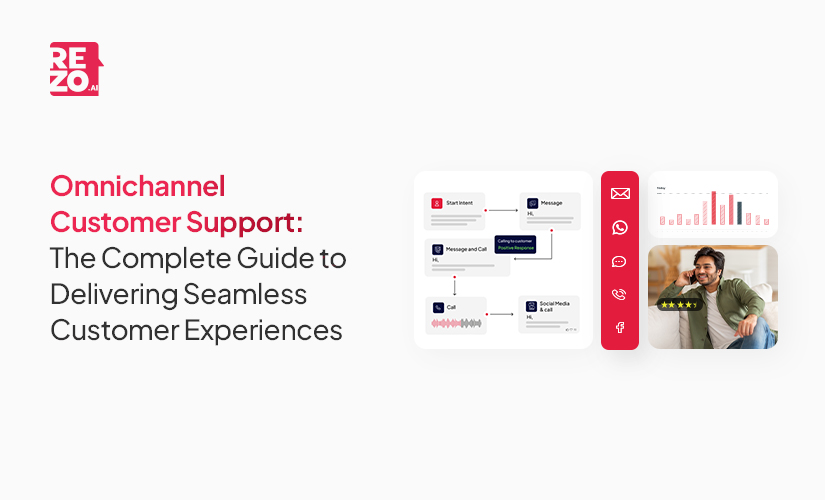
Multilingual Customer Support: The Complete Guide for Global CX Leaders
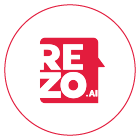
Multilingual Customer Support: The Complete Guide for Global CX Leaders


Here's a number that should grab your attention: 76% of online shoppers prefer to buy products with information in their native language and 40% will never buy from websites in other languages.
Think about that for a moment. Nearly half of your potential customers could be walking away before they ever engage with your product or service, simply because you're not speaking the customer's preferred language.
For CX leaders and executives navigating today's diverse markets with a global customer base, language isn't just a communication challenge, it's a business-critical factor that directly impacts your bottom line. As your organization expands into new markets, multilingual customer support shifts from a nice-to-have feature to a competitive necessity.
In this comprehensive guide, we'll explore what multilingual customer support really means, why it matters for enterprise growth, how it boosts customer satisfaction the challenges you'll face, and most importantly how modern AI technology makes it scalable and cost-effective. Whether you're considering your first non-English support channel or looking to optimize an existing multilingual operation, you'll find actionable strategies to drive measurable results.
What is Multilingual Customer Support?
Multilingual customer support goes far beyond simply translating your FAQ page. It's about delivering seamless, culturally appropriate customer service experiences across multiple languages and channels.
Beyond Translation: The Full Spectrum of Multilingual Customer Service
Multilingual customer support refers to a system where customers can interact with your brand in their preferred language across every touchpoint:- phone, email, chat, social media, and self-service portals. It's not just about what you say, but how you say it. Cultural nuances, local idioms, and regional preferences all play a role in creating authentic experiences.
For example, a direct communication style that works well in Germany might feel abrupt to customers in Japan, where indirect, polite language is preferred. True multilingual customer support accounts for these cultural dimensions.
Types of Multilingual Support Models
Organizations typically provide multilingual customer support through three approaches:
- Human agents: Native or fluent speakers providing personalized support
- AI-powered chatbots: Automated systems handling routine queries across languages
- Hybrid models: Combining AI efficiency with human expertise for complex issues
Modern enterprises are increasingly adopting hybrid models. According to Gartner, 80% of customer service organizations will use generative AI by 2025, making it possible to handle routine multiple language interactions at scale while hiring native speakers for situations requiring cultural sensitivity or complex problem-solving.
CX Automation platform enable this hybrid approach through AI agents using conversational AI, automatically detecting customer language preferences and routing inquiries to the appropriate AI agent or human specialist.

The Difference Between Multilingual and Localized Support
Here's a subtle but important distinction:- A multilingual support system speaks your customer's language, while localized support speaks to their culture. Localization includes adapting everything from date formats and currency to payment methods and customer service hours that align with local time zones.
The most effective global support strategies combine both elements, ensuring customers feel understood not just linguistically, but culturally.
Why Multilingual Customer Support Matters for Enterprise Growth?
Let's talk business impact. If you're a CX leader presenting the case for multilingual support to your C-suite, you need compelling ROI justification. The data tells a clear story.
The Business Case: Revenue Impact
Providing support in your customers’ native or preferred language can significantly impact revenue and enhance customer satisfaction. Consider your customer acquisition costs. Now imagine 40 percent of your target audience dropping out of your funnel due to language barriers. That is not just lost revenue; it is wasted marketing investment and missed growth opportunities.
Customer Retention and Loyalty
Here's where multilingual support becomes a retention superpower. Industry report shows customers are more likely to engage with a company that assists customers in their own language, and companies with trained multilingual support agents see increase in customer retention rates.
In an era where a majority leaders say improving CX is a top priority, language accessibility is one of the highest-impact levers you can pull. It's not just about solving problems, it's about providing quality multilingual support to enhance customer experience.
Measuring this impact is crucial. Tools for tracking CSAT help you quantify how language specific support affects your satisfaction scores across different markets.
Market Expansion Opportunities
Multilingual support isn't just defensive (keeping customers you have), it's offensive strategy for tapping into diverse customer base. When you can provide multi-language support from day one, you remove one of the biggest barriers to international expansion.
Consider this: the fastest-growing consumer markets are in Asia, Latin America, and Africa. Regions where English proficiency varies widely. Your ability to support customers in Mandarin, Spanish, Portuguese, Hindi, or Arabic directly correlates to your addressable market size.
Competitive Differentiation
With 80% of organizations expecting to compete based on CX , multilingual support becomes a clear differentiator. When two products have similar features and pricing, the one that provides clear communication in customer's preferred language.
This is especially true in B2B contexts. Enterprise buyers expect vendor support teams to address customer concerns and communicate fluently in their business language. It signals commitment to the partnership and reduces friction in complex implementations and also helps in building a global presence.
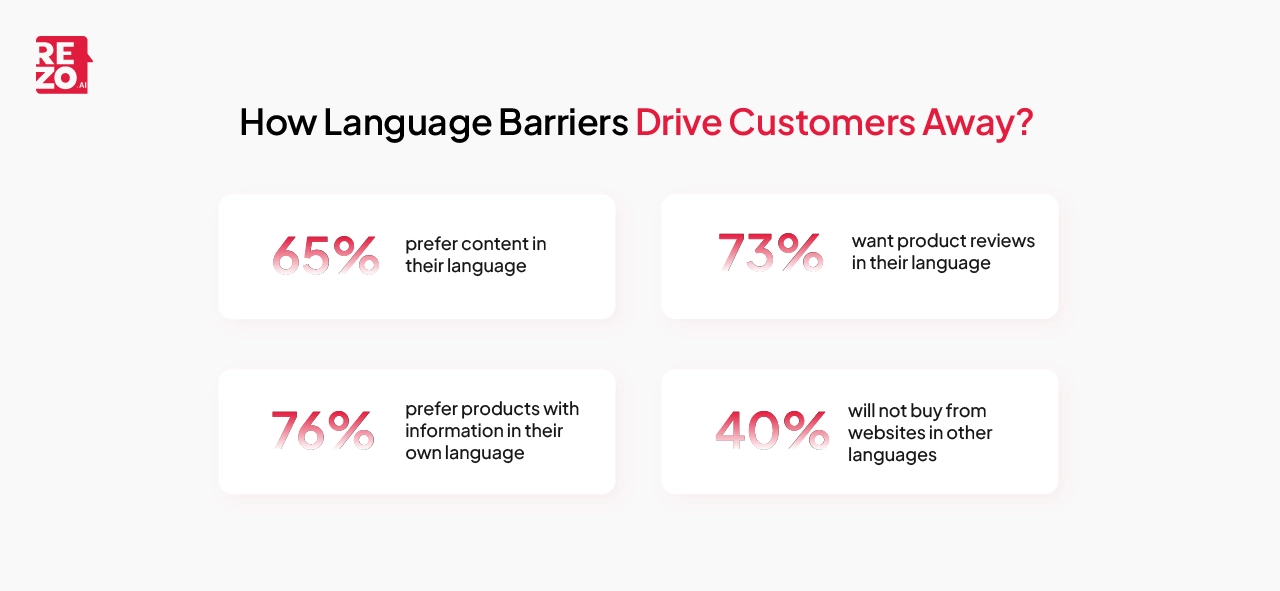
Common Challenges in Implementing Multilingual Customer Support
Let's be realistic implementing and scaling multilingual support isn't without its challenges. Understanding these obstacles upfront helps you provide multilingual support more effectively.
Cost and Resource Constraints
The traditional model of hiring native-speaking agents for every language you want to support can be prohibitively expensive. Salary costs vary by region, but the infrastructure, training programs, quality assurance, management layers, all multiplies quickly.
Here's the trap many organizations fall into: they budget for the languages but underestimate the operational complexity of managing multiple language teams simultaneously.
Finding and Retaining Multilingual Talent
More than half of the contact center leaders face staffing shortages. Now add the requirement for specific language skills, and the talent challenge intensifies.
Qualified in house multilingual team command premium salaries, and attrition rate in contact centers can go up to 60% annually. Every departure means not just replacing a support agent, but replacing that specific language capability often with months of lead time.
This is precisely the problem that AI-powered translation tools and support agents address. Modern platforms can handle majority of basic customer inquiries across multiple languages, reserving your human talent for the interactions that truly require cultural intuition and complex problem-solving.
Maintaining Consistency Across Languages
Brand voice consistency is challenging enough in one language. Multiply that across five, ten, or twenty languages, and quality control becomes exponentially more complex.
How do you ensure your brand personality translates authentically? How do you prevent one language team from making policy promises that don't align with what another team communicated? These consistency challenges require robust processes and technology to maintain unified customer experiences.
Technology Integration Complexity
Your multi language customer service solutions needs to integrate with your existing CRM, ticketing system, knowledge base, and analytics platforms. Legacy systems weren't always built with multilingual capabilities in mind, creating integration headaches and data silos.
The good news? Modern AI translation tools and platforms powered are designed for integration from the ground up, with APIs and pre-built connectors that simplify deployment.
Technology Solutions for Multilingual Customer Support
Technology, especially artificial intelligence, is transforming what’s possible in multilingual customer support. Solutions that seemed like science fiction just five years ago are now fully enterprise-ready, enabling businesses to deliver seamless, real-time support in multiple languages with unprecedented accuracy and efficiency.
AI-Powered Translation and Conversational AI
Generative AI has transformed translation quality. We've moved far beyond the clunky, literal translations of early machine translation. Today's AI models understand context, idioms, intent and have language proficiency.
Agentic AI agents can now hold natural conversations across languages, maintaining context throughout multilingual live chats. The AI doesn't just provide with real time translation tools, it understands the customer expectations and offers support appropriately thus providing the customer with an efficient multilingual support journey.
According to Salesforce 92% of organizations say generative AI helps them deliver better customer service and 95% report cost and time savings. These aren't marginal improvements, they are transformational results.
Real-Time Language Detection
Modern systems automatically detect the customer's language from their first message or utterance, no need for explicit language selection menus. This creates frictionless experiences where customers simply start communicating in their preferred language, and the system adapts to provide instant multilingual support.
For voice support, this technology has advanced remarkably. AI can now identify language and dialect within seconds of a call beginning, routing to the appropriate agent or AI system without frustrating IVR menus.
Multilingual Knowledge Bases
Your knowledge base is only as useful as your customers' ability to access it. AI-powered multilingual knowledge bases automatically translate and localize content, keeping information current across all languages simultaneously.
When you update an article in English, the changes can propagate across all language versions, with AI ensuring cultural appropriateness while maintaining consistency.
Speech-to-Text and Voice Support Across Languages
Voice remains a preferred channel for many customers, especially for complex issues. Modern Voice AI agents can handle phone conversations in multiple languages, understanding accents, handling background noise, and even detecting emotional tone.
How to Implement Multilingual Customer Support?
Strategy matters as much as technology. Here's how to approach multilingual customer support implementation to enhance customer experience and drive ROI.
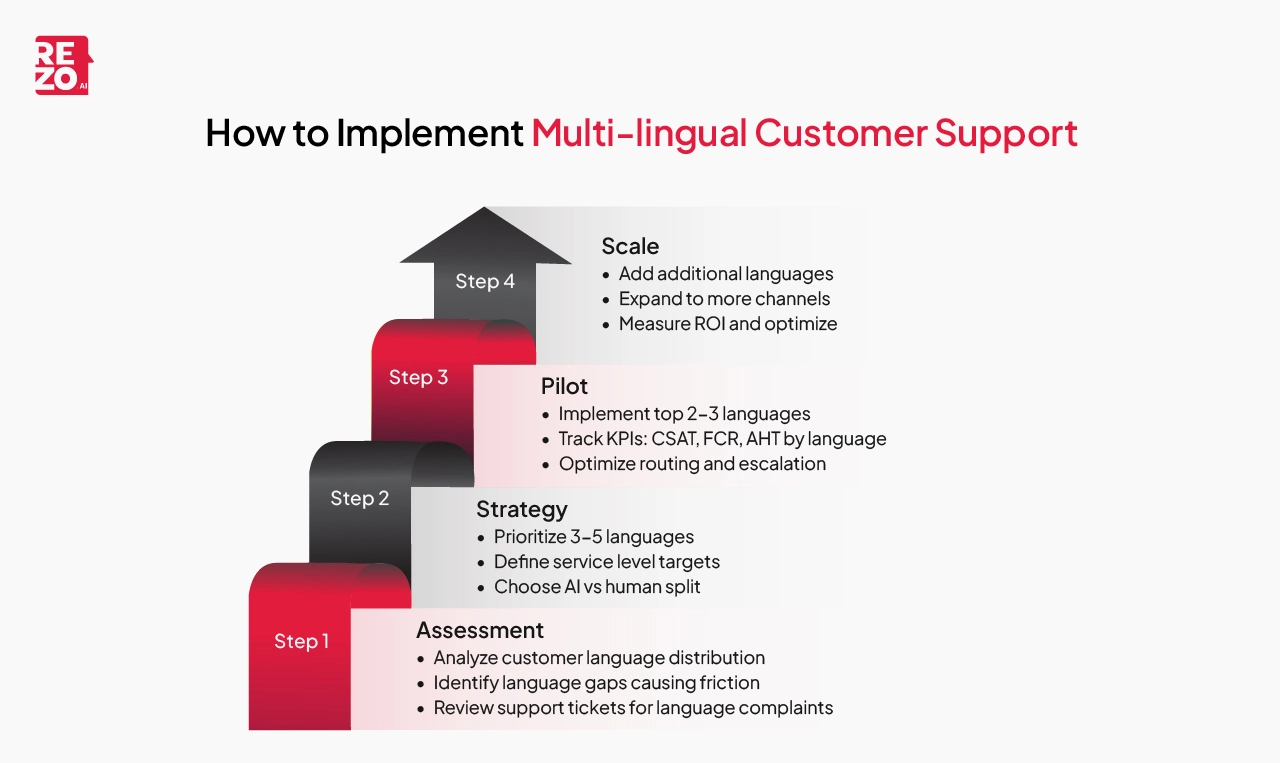
Start with Data: Identify Your Language Priorities
Don't try to support every language at once. Start by analyzing your customer data:
- What languages do your current customers speak?
- Which markets represent your biggest growth opportunities?
- Where are you losing customers due to language barriers?
Use this data to understand customer demand and prioritize your first three to five languages. You can always expand later, but focus creates faster ROI.
Build a Hybrid Model (Human + AI)
The optimal model combines AI efficiency with human expertise to deliver support. Here's a practical framework:
- Tier 1 - AI handles: FAQs, order status, basic troubleshooting, account information
- Tier 2 - Human agents handle: Complex technical issues, sensitive situations, escalated complaints
- Tier 3 - Specialized agents handle: Sales, technical implementations, executive relationships
Research shows that while customers prefer live interpretation over automated translation for complex issues, they're perfectly comfortable with AI for routine queries. The key is intelligent routing that recognizes when to escalate.
Invest in Cultural Training
Technology handles translation, but humans ensure cultural appropriateness. Invest in training that goes beyond language fluency to cultural competency.
Teach your multilingual customer support teams (and inform your AI training) about:
- Cultural communication norms (direct vs. indirect)
- Local holidays and customs
- Regional business practices
- Sensitive topics specific to each culture
This training prevents missteps that could damage customer relationships or your brand reputation.
Measure and Optimize Performance
What gets measured gets improved. Track these KPIs for your multilingual support:
- First contact resolution rate by language
- Customer satisfaction scores by language
- Average handle time by language
- AI containment rate (percentage of issues resolved without human escalation)
- Language preference accuracy (are you correctly identifying customer language?)
- Cost per interaction by language
Look for patterns. Are certain languages showing lower satisfaction? Higher handle times? These metrics guide your optimization efforts.
The ROI of Multilingual Customer Support
Let's talk numbers. How do you justify the investment in multilingual support to your CFO?
Revenue Impact: Increased Conversion and Retention
Start with the baseline statistics:
- 65% customer prefer native language support
- 40% customers will not pick companies with no multilingual capabilities
- 76% customers prefer product information in native language
Now apply these to your business metrics. If your customer lifetime value is $10,000 and you retain 30% more customers through multilingual support, that's $3,000 additional value per retained customer. Multiply that across your customer base, and you're looking at substantial revenue impact.
On the acquisition side, if language barriers are causing 40% of prospects to bounce, removing that barrier expands your addressable market significantly.
Cost Optimization Through AI
Here's the cost transformation story: AI can handle majority of basic queries at a fraction of the cost of human agents. While a human multilingual agent might cost $15-30 per hour (varying by region), AI interactions cost pennies.
Let's say you handle 100,000 customer interactions monthly across five languages:
- Traditional model: 100,000 interactions × $5 average cost = $500,000/month
- AI-hybrid model: 80,000 AI interactions × $0.50 + 20,000 human × $5 = $140,000/month
That's $360,000 monthly savings, or $4.3 million annually—while often delivering faster response times and 24/7 availability.
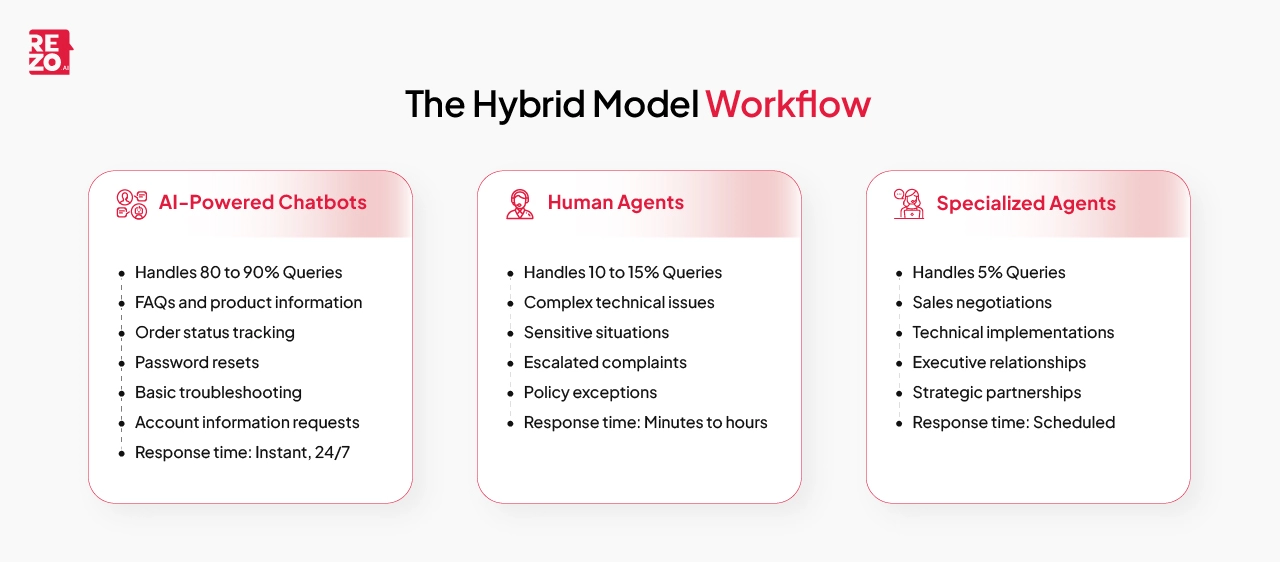
Market Expansion ROI
When evaluating new market entry, multilingual support capabilities should be part of your go-to-market costs. But unlike many market entry expenses, multilingual AI infrastructure scales efficiently, supporting customers in France, Mexico, and Japan doesn't cost three times as much as supporting one market.
This scalability fundamentally changes the economics of global expansion.
Calculating Your Multilingual Support ROI
Here's a simple framework:
Benefits:
- Retained revenue from improved retention (retention rate increase × CLV)
- New revenue from expanded market access (market size × conversion rate)
- Saved costs from AI automation (interactions automated × cost difference)
Costs:
- Technology platform fees
- Implementation and integration costs
- Human agent costs for escalated interactions
- Training and quality assurance programs
Most enterprises see positive ROI within 6-12 months, with benefits accelerating as AI systems learn and improve over time.
Future Trends in Multilingual Customer Support
The pace of innovation in this space is remarkable. Here's what's coming.
Advances in Real-Time Translation AI
Next-generation AI models will understand even more nuance, handling regional dialects, slang, and code-switching (when speakers mix languages in a single conversation). The gap between native speaker quality and AI translation services continues to narrow.
Voice AI and Accent Understanding
Accent recognition is improving rapidly. Future systems will understand heavily accented English as easily as they understand regional variations of Spanish or Mandarin. This means your voice AI won't frustrate customers by misunderstanding their pronunciation.
Predictive Language Preferences
AI will predict language preferences based on context before the customer even speaks analyzing IP address, previous interaction history, account information, and behavioral patterns to proactively offer support in the most likely preferred language.
Emotion Detection Across Languages
Advanced Voice AI Agents will detect emotional states like frustration, satisfaction, confusion, etc across languages, allowing AI to adjust tone and know when to escalate to human agents based on emotional cues, not just conversation complexity.
For forward-thinking CX leaders, understanding how AI agents will help in scalability of the organization in the future.
Roadmap to Implement Multilingual Customer Support
Ready to implement or improve your multilingual support? Here's your practical roadmap.
Step 1:- Assess Your Current State
Start with an honest assessment:
- How many languages do you currently support (officially and unofficially)?
- What's your customer language distribution?
- What channels do customers use to contact you?
- Where are your current language gaps causing friction?
Analyze support tickets and customer feedback for language-related complaints. Look for markets where you're losing customers or failing to gain traction.
Step 2:- Define Your Multilingual Strategy
Based on your assessment, define:
- Priority languages: Start with 3-5 languages representing the most impact
- Channel strategy: Will you offer multilingual support across all channels or start with specific ones?
- Service level targets: Define response times and availability by language
- AI vs. human split: Where will you deploy automation vs. human agents?
Step 3:- Choose the Right Technology Partner
Evaluate potential platforms on:
- Language coverage (current and planned expansion)
- Integration capabilities with your existing tech stack
- AI quality and training capabilities
- Voice and text support
- Analytics and reporting
- Scalability and pricing model
- Implementation support and timeline
Look for platforms with proven enterprise deployments. Ask for references from companies in similar industries handling comparable volumes.
Step 4:- Pilot, Measure, and Scale
Don't boil the ocean. Start with:
- Pilot phase: Implement your top 2-3 priority languages
- Measure rigorously: Track all the KPIs we discussed earlier
- Optimize: Refine your AI training, routing rules, and escalation paths
- Scale: Add additional languages and channels based on pilot learnings
This phased approach reduces risk and builds organizational confidence through early wins.
Conclusion: Language as Competitive Advantage
The traditional barriers to multilingual support:- cost, complexity, talent scarcity, are dissolving thanks to AI technology. What once required massive teams of multilingual agents can now be handled by hybrid models that combine AI efficiency with human expertise, delivering 10-20% improvements in customer satisfaction while reducing costs.
The organizations winning in global markets aren't those with the biggest support budgets. They're those leveraging modern technology to deliver personalized, culturally appropriate experiences at scale.
As AI continues advancing, the competitive advantage won't come from simply having multilingual capabilities. It'll come from how seamlessly, personally, and efficiently you deliver them.
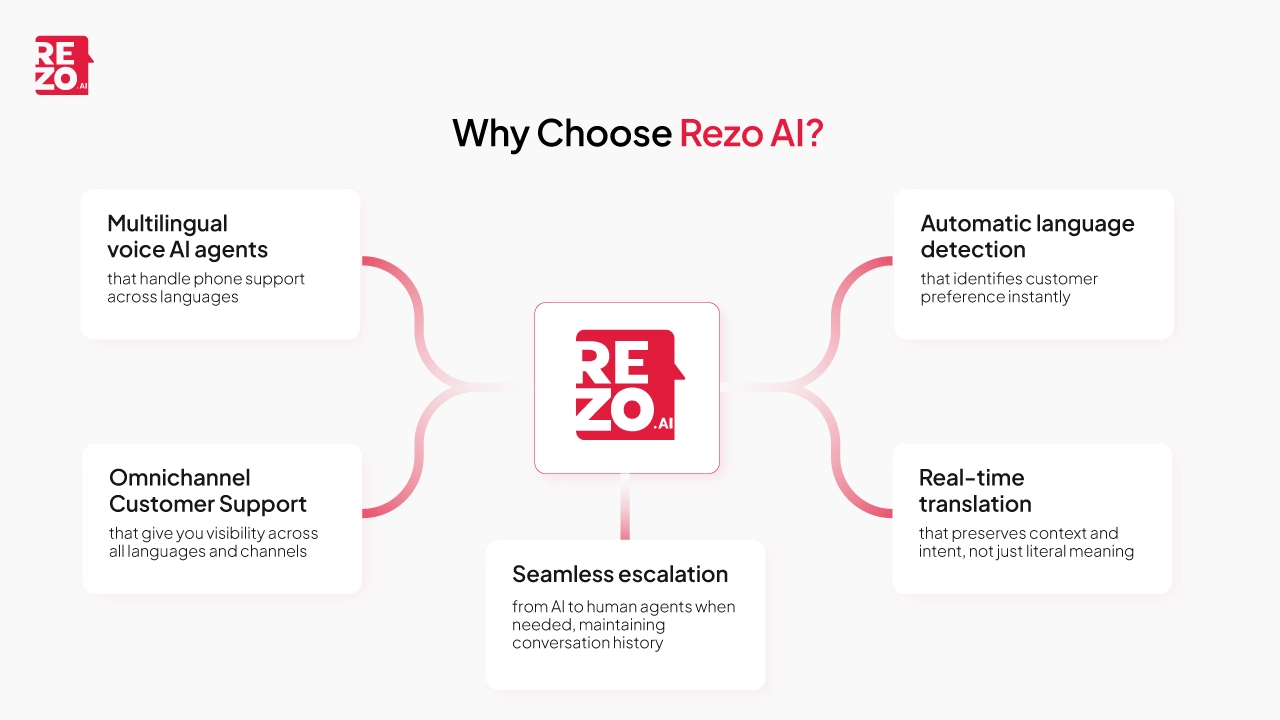
Frequently Asked Questions
What is the benefit for multilingual businesses?
A business that provides multilingual customer support can tap into a diverse audience base and expand its reach into global markets by offering assistance in multiple languages.
What languages are supported by Rezo AI?
Rezo.AI supports over multiple languages, including regional languages such as Hindi, Bengali, and Tamil, as well as international languages like Mandarin, Arabic, and more. This capability enables us to deliver truly effective multilingual customer support for our clients.
What are the features of a multilingual customer support AI agent?
A multilingual customer support AI agent is an AI-powered assistant that interacts with customers in different languages. It leverages Natural Language Processing (NLP) and Machine Learning algorithms to deliver contextual, hyper-personalized, and human-like interactions.
How can I implement multilingual customer support for my company?
To implement multilingual customer support, CX leaders should begin by identifying the languages they need to support and determining the preferred workflow, whether human led, AI driven, or a hybrid model. Once this is defined, they can either establish an in-house multilingual support center or partner with CX automation platforms like Rezo.AI to streamline and scale their operations.
Frequently Asked Questions (FAQs)

Take the leap towards innovation with Rezo.ai
Get started now







